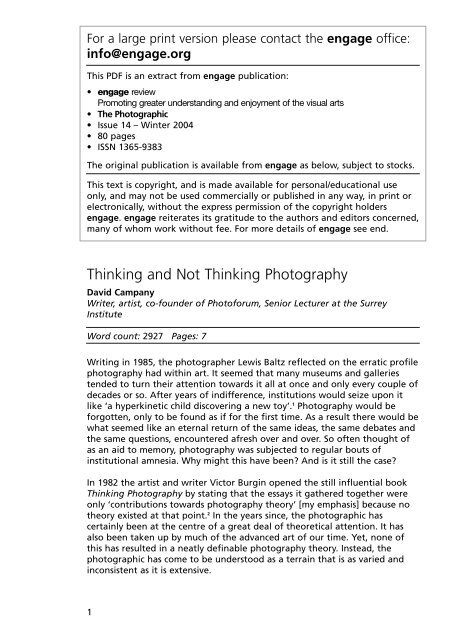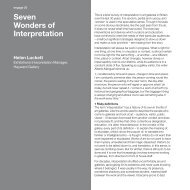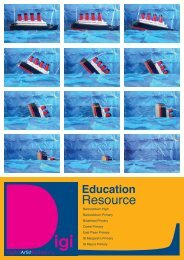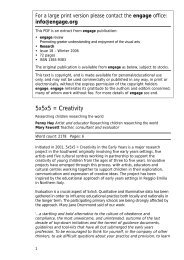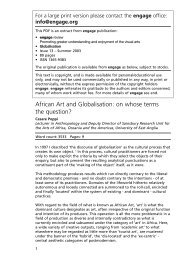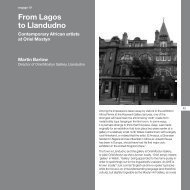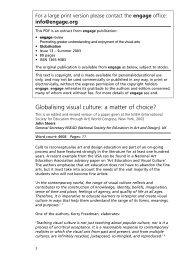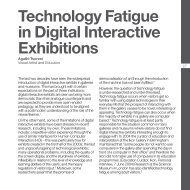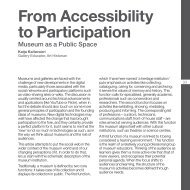to download the PDF - Engage
to download the PDF - Engage
to download the PDF - Engage
You also want an ePaper? Increase the reach of your titles
YUMPU automatically turns print PDFs into web optimized ePapers that Google loves.
For a large print version please contact <strong>the</strong> engage office:<br />
info@engage.org<br />
This <strong>PDF</strong> is an extract from engage publication:<br />
• engage review<br />
Promoting greater understanding and enjoyment of <strong>the</strong> visual arts<br />
• The Pho<strong>to</strong>graphic<br />
• Issue 14 – Winter 2004<br />
• 80 pages<br />
• ISSN 1365-9383<br />
The original publication is available from engage as below, subject <strong>to</strong> s<strong>to</strong>cks.<br />
This text is copyright, and is made available for personal/educational use<br />
only, and may not be used commercially or published in any way, in print or<br />
electronically, without <strong>the</strong> express permission of <strong>the</strong> copyright holders<br />
engage. engage reiterates its gratitude <strong>to</strong> <strong>the</strong> authors and edi<strong>to</strong>rs concerned,<br />
many of whom work without fee. For more details of engage see end.<br />
Thinking and Not Thinking Pho<strong>to</strong>graphy<br />
David Campany<br />
Writer, artist, co-founder of Pho<strong>to</strong>forum, Senior Lecturer at <strong>the</strong> Surrey<br />
Institute<br />
Word count: 2927 Pages: 7<br />
Writing in 1985, <strong>the</strong> pho<strong>to</strong>grapher Lewis Baltz reflected on <strong>the</strong> erratic profile<br />
pho<strong>to</strong>graphy had within art. It seemed that many museums and galleries<br />
tended <strong>to</strong> turn <strong>the</strong>ir attention <strong>to</strong>wards it all at once and only every couple of<br />
decades or so. After years of indifference, institutions would seize upon it<br />
like ‘a hyperkinetic child discovering a new <strong>to</strong>y’. 1 Pho<strong>to</strong>graphy would be<br />
forgotten, only <strong>to</strong> be found as if for <strong>the</strong> first time. As a result <strong>the</strong>re would be<br />
what seemed like an eternal return of <strong>the</strong> same ideas, <strong>the</strong> same debates and<br />
<strong>the</strong> same questions, encountered afresh over and over. So often thought of<br />
as an aid <strong>to</strong> memory, pho<strong>to</strong>graphy was subjected <strong>to</strong> regular bouts of<br />
institutional amnesia. Why might this have been? And is it still <strong>the</strong> case?<br />
In 1982 <strong>the</strong> artist and writer Vic<strong>to</strong>r Burgin opened <strong>the</strong> still influential book<br />
Thinking Pho<strong>to</strong>graphy by stating that <strong>the</strong> essays it ga<strong>the</strong>red <strong>to</strong>ge<strong>the</strong>r were<br />
only ‘contributions <strong>to</strong>wards pho<strong>to</strong>graphy <strong>the</strong>ory’ [my emphasis] because no<br />
<strong>the</strong>ory existed at that point. 2 In <strong>the</strong> years since, <strong>the</strong> pho<strong>to</strong>graphic has<br />
certainly been at <strong>the</strong> centre of a great deal of <strong>the</strong>oretical attention. It has<br />
also been taken up by much of <strong>the</strong> advanced art of our time. Yet, none of<br />
this has resulted in a neatly definable pho<strong>to</strong>graphy <strong>the</strong>ory. Instead, <strong>the</strong><br />
pho<strong>to</strong>graphic has come <strong>to</strong> be unders<strong>to</strong>od as a terrain that is as varied and<br />
inconsistent as it is extensive.<br />
1
A pho<strong>to</strong>graph might be a fixed image but, socially speaking, pho<strong>to</strong>graphy<br />
does not keep still. A pho<strong>to</strong>graph might be sharp but <strong>the</strong> <strong>to</strong>tality of all that<br />
is pho<strong>to</strong>graphic can’t be held in focus. It is <strong>to</strong>o big and <strong>to</strong>o diffuse <strong>to</strong> be a<br />
unified field. It is resistant <strong>to</strong> definition, not least because culture does so<br />
many different things with it and <strong>the</strong>se things change over time. It escapes<br />
fixed formulation in such a way that it is never fully satisfying, or perhaps<br />
even possible, <strong>to</strong> say once and for all what it is, ei<strong>the</strong>r on a technical level or<br />
a cultural level. This is what <strong>the</strong> <strong>the</strong>orist Peter Osborne has recently called<br />
<strong>the</strong> ‘peculiar generality of <strong>the</strong> pho<strong>to</strong>graphic image’. 3 And it is this peculiarity<br />
that generates <strong>the</strong> inevitable inconsistencies in <strong>the</strong> way it is approached and<br />
thought.<br />
Despite <strong>the</strong> peaks and troughs in <strong>the</strong> profile of pho<strong>to</strong>graphy, its effects on<br />
art culture over <strong>the</strong> last century have been enormous. However, nei<strong>the</strong>r of its<br />
two major impacts has happened in <strong>the</strong> name of a distinct or distinctive<br />
medium. Firstly <strong>the</strong>re is <strong>the</strong> matter of reproduction. Pho<strong>to</strong>graphy has been<br />
<strong>the</strong> silent media<strong>to</strong>r of all art for over a century now. Art comes <strong>to</strong> us via<br />
books, catalogues, magazines, slides, posters, postcards, web pages and so<br />
on. The cultural critic Walter Benjamin recognised this as early as 1931. ‘It is<br />
indeed significant’ he pointed out, ‘that <strong>the</strong> debate has raged most fiercely<br />
around <strong>the</strong> aes<strong>the</strong>tics of pho<strong>to</strong>graphy as art, whereas <strong>the</strong> far less<br />
questionable social fact of art as pho<strong>to</strong>graphy was given scarcely a glance.<br />
And yet <strong>the</strong> impact of <strong>the</strong> pho<strong>to</strong>graphic reproduction of art works is of very<br />
much greater importance for <strong>the</strong> function of art than <strong>the</strong> greater or lesser<br />
artistry of a pho<strong>to</strong>graphy that regards all experience as fair game for <strong>the</strong><br />
camera.’ 4<br />
Understandably, it is sometimes hard for those with a commitment <strong>to</strong><br />
pho<strong>to</strong>graphy <strong>to</strong> swallow <strong>the</strong> fact that <strong>the</strong> medium has had its most profound<br />
effect when at its most neutral, in its most subservient role. The tension<br />
between <strong>the</strong> ambitions of self-conscious art pho<strong>to</strong>graphy and <strong>the</strong> artless<br />
pho<strong>to</strong>graphy of art can never be entirely reconciled. As Mark Haworth-Booth<br />
of <strong>the</strong> Vic<strong>to</strong>ria and Albert Museum points out, ‘this unresolved conflict is very<br />
much part of <strong>the</strong><br />
medium’s his<strong>to</strong>ry.’ 5<br />
Secondly, and not unrelated <strong>to</strong> Benjamin’s remark, is <strong>the</strong> fact that<br />
pho<strong>to</strong>graphy spliced itself most forcefully in<strong>to</strong> <strong>the</strong> vanguard art of <strong>the</strong><br />
second half of <strong>the</strong> twentieth century on <strong>the</strong> basis of its artless, general and<br />
anonymous social character. It was its apparent lack of specific qualities that<br />
made it so attractive <strong>to</strong> Pop art, Conceptualism and <strong>the</strong> art that has<br />
followed. Unencumbered by <strong>the</strong> weight of tradition, pho<strong>to</strong>graphy held out<br />
<strong>the</strong> possibility of reconnecting art and social life after years of abstraction<br />
and o<strong>the</strong>r conservative reductions. Hence <strong>the</strong> active embrace of pho<strong>to</strong>graphy<br />
as an industrial, au<strong>to</strong>mated and de-skilled technology. We see this in <strong>the</strong><br />
silkscreens of Andy Warhol, in <strong>the</strong> mass produced pho<strong>to</strong> books of Edward<br />
Ruscha with <strong>the</strong>ir mimicry of bureaucratic snaps, and in <strong>the</strong> simple pho<strong>to</strong>s<br />
made by Bruce Nauman <strong>to</strong> document his performances and ephemeral<br />
sculptures. Hence also <strong>the</strong> term ‘artists using pho<strong>to</strong>graphy’ that designated a<br />
less protective, less guarded loyalty <strong>to</strong> a definable medium than that<br />
traditionally held by art pho<strong>to</strong>graphers.<br />
2
Their thoughtful use of pho<strong>to</strong>graphy in deliberately impure, promiscuous<br />
ways was a critical reworking of <strong>the</strong> unthinking promiscuity of <strong>the</strong><br />
pho<strong>to</strong>graph in capitalism’s mass culture. Even in <strong>the</strong> more elaborate artistic<br />
strategies of recent years, pho<strong>to</strong>graphic purity is rarely a concern. In <strong>the</strong><br />
staged tableaux (typified by Jeff Wall or Cindy Sherman) and <strong>the</strong> grand vista<br />
(typified by Andreas Gursky) that are currently so widely exhibited, <strong>the</strong><br />
creativity, skills and references are rarely particular <strong>to</strong> <strong>the</strong> medium. Instead<br />
artists import <strong>the</strong> techniques of painting, literature and cinema, working<br />
with a hybrid conception of pho<strong>to</strong>graphy.<br />
Describing <strong>the</strong> role played by pho<strong>to</strong>graphy in art of <strong>the</strong> 1960s and 1970s, Jeff<br />
Wall has used <strong>the</strong> term ‘<strong>the</strong> art concept of pho<strong>to</strong>journalism’. 6 He was<br />
referring <strong>to</strong> <strong>the</strong> way <strong>the</strong> important art of that time unders<strong>to</strong>od pho<strong>to</strong>graphy<br />
in its worldly condition - as a set of embedded social practices that could be<br />
analysed, critiqued, challenged and subverted. Artists probed pho<strong>to</strong>graphy’s<br />
assumed role as social fact in news, science and law, opening up a space <strong>to</strong><br />
reflect upon <strong>the</strong> authority often given <strong>to</strong> pho<strong>to</strong>graphs in daily life.<br />
This turn of pho<strong>to</strong>graphy in art <strong>to</strong>wards a reflection on pho<strong>to</strong>graphy’s roles<br />
outside of art has become its most important mode. Pho<strong>to</strong>graphy has not<br />
entered art on an independent footing but as something inextricably bound<br />
up with non-art, and with <strong>the</strong> pho<strong>to</strong>graphic in all of culture’s spaces. Today<br />
we see practitioners and cura<strong>to</strong>rs working with ‘art concepts’ of all <strong>the</strong><br />
various fields of pho<strong>to</strong>graphy. For example, Tate Modern’s recent show Cruel<br />
and Tender: <strong>the</strong> Real in <strong>the</strong> Twentieth Century Pho<strong>to</strong>graph was a<br />
presentation of <strong>the</strong> art concept of <strong>the</strong> document (more of which later).<br />
More broadly we have seen <strong>the</strong> art concept of <strong>the</strong> fashion image; of <strong>the</strong><br />
snapshot; of <strong>the</strong> portrait; of <strong>the</strong> medical pho<strong>to</strong>graph, <strong>the</strong> architectural<br />
pho<strong>to</strong>graph; <strong>the</strong> film still; <strong>the</strong> passport pho<strong>to</strong>; <strong>the</strong> archival image; <strong>the</strong> penal<br />
image; of kitsch; of <strong>the</strong> <strong>to</strong>pographic image and so on. The gallery has<br />
become <strong>the</strong> space <strong>to</strong> look askew at <strong>the</strong> general field of <strong>the</strong> pho<strong>to</strong>graphic, <strong>to</strong><br />
engage directly or indirectly with a commentary upon <strong>the</strong> image world at<br />
large. The space of art has thus come <strong>to</strong> function ei<strong>the</strong>r as a dissecting table<br />
<strong>to</strong> which <strong>the</strong> different forms of <strong>the</strong> pho<strong>to</strong>graphic are brought for creative<br />
reflection, or as a set upon which <strong>the</strong>y can be reworked. These two<br />
metaphors - dissecting table and set - map quite well on<strong>to</strong> what seem <strong>to</strong> be<br />
<strong>the</strong> two key impulses behind much current pho<strong>to</strong>graphic art: <strong>the</strong> forensic<br />
interest in detail and <strong>the</strong> cinematic interest in mise-en-scène. These impulses<br />
are so forcefully present <strong>to</strong>day because all pho<strong>to</strong>graphy in art is somehow<br />
obliged <strong>to</strong> enter in<strong>to</strong> a dialogue ei<strong>the</strong>r with <strong>the</strong> notion of <strong>the</strong> pho<strong>to</strong> as visual<br />
evidence, or with <strong>the</strong> culture of <strong>the</strong> moving image in which <strong>the</strong> still now<br />
finds itself, or both.<br />
The question of dialogue, of exchange, is of course ana<strong>the</strong>ma <strong>to</strong> <strong>the</strong> thinking<br />
or making of pho<strong>to</strong>graphy ‘purely on its own terms’. Never<strong>the</strong>less, <strong>the</strong> desire<br />
<strong>to</strong> discover a core of what might be particular <strong>to</strong> pho<strong>to</strong>graphy, and universal<br />
<strong>to</strong> all pho<strong>to</strong>graphy, is still very seductive both in art and in <strong>the</strong>oretical<br />
writing. Indeed it may well be that <strong>the</strong> compulsion <strong>to</strong> fix <strong>the</strong> identity of<br />
pho<strong>to</strong>graphy is directly proportional <strong>to</strong> <strong>the</strong> difficulty of doing so. This is<br />
encapsulated neatly by <strong>the</strong> different writings on pho<strong>to</strong>graphy by one of its<br />
most influential commenta<strong>to</strong>rs, Roland Bar<strong>the</strong>s. Camera Lucida (1980), his<br />
3
final book, was a search for an essence of pho<strong>to</strong>graphy, a search made in<br />
(and prompted by) a state of personal mourning for his deceased mo<strong>the</strong>r. 7<br />
Bar<strong>the</strong>s gazed alone at images, in his own time, away from mass culture. He<br />
located <strong>the</strong> essence in <strong>the</strong> pho<strong>to</strong>graph’s embodiment of mortality and its<br />
relation <strong>to</strong> <strong>the</strong> past. All pho<strong>to</strong>graphs have this, he argues, but it is palpable<br />
in just a few, viewed in <strong>the</strong> right frame of mind. The book is <strong>the</strong> closest thing<br />
pho<strong>to</strong> <strong>the</strong>ory has <strong>to</strong> a best-seller (along with Susan Sontag’s On<br />
Pho<strong>to</strong>graphy, 1977). It is still widely read by artists and students of<br />
pho<strong>to</strong>graphy. Famously though, Bar<strong>the</strong>s had little more than contempt for<br />
art pho<strong>to</strong>graphy, it being a perversion of <strong>the</strong> uncanny mechanism which for<br />
him really defined <strong>the</strong> pho<strong>to</strong>graphic. For Bar<strong>the</strong>s it is <strong>the</strong> viewer who must<br />
do all <strong>the</strong> thinking about image, not <strong>the</strong> pho<strong>to</strong>grapher. By contrast in his<br />
earlier writings Bar<strong>the</strong>s had been less interested in pinning down some<br />
elusive and perhaps non-existent core than looking at pho<strong>to</strong>graphy’s<br />
dispersed social effects as news, publicity and advertising in mass media. 8<br />
Here <strong>the</strong> meaning of pho<strong>to</strong>graphy is located in its basis as <strong>the</strong> most culturally<br />
widespread form of representation. What he <strong>the</strong>orised was <strong>the</strong> way <strong>the</strong><br />
pho<strong>to</strong>graphs we see fashion opinion and how opinion <strong>the</strong>n fashions <strong>the</strong><br />
pho<strong>to</strong>graphs we see.<br />
A reader moving across <strong>the</strong> divide in Bar<strong>the</strong>s’ writings will detect a pull<br />
between <strong>the</strong> different approaches, between thinking directly and thinking<br />
indirectly about pho<strong>to</strong>graphy. The pull is far from unique <strong>to</strong> Bar<strong>the</strong>s. The<br />
oscillation structures our everyday experience of images: at some points we<br />
absorb <strong>the</strong>m, even rely on <strong>the</strong>m, while at o<strong>the</strong>rs we question and reflect on<br />
<strong>the</strong>m. This can seen be in <strong>the</strong> recent attempts <strong>to</strong> piece <strong>to</strong>ge<strong>the</strong>r<br />
pho<strong>to</strong>graphy’s past in book form. Michel Frizot’s The New His<strong>to</strong>ry of<br />
Pho<strong>to</strong>graphy (1998) and Mary Warner Marien’s Pho<strong>to</strong>graphy: A Cultural<br />
His<strong>to</strong>ry (2002) are as vast and sprawling as <strong>the</strong>ir subject is when thought<br />
about in its widest sense. Despite <strong>the</strong> word ‘his<strong>to</strong>ry’ appearing in <strong>the</strong> singular<br />
in <strong>the</strong>ir titles, each book is itself a consummate patchwork of<br />
incommensurate his<strong>to</strong>ries. Where once pho<strong>to</strong>graphy was narrated as a single<br />
linear narrative marked out by technical and creative innovation, now it is a<br />
subject that barely unifies itself at all, even in books of over five hundred<br />
pages. 9 This is a notable shift. Today it is pho<strong>to</strong>graphy’s <strong>to</strong>tal dispersal that<br />
warrants special attention.<br />
The movement between pho<strong>to</strong>graphy as something <strong>to</strong> be approached headon<br />
and something <strong>to</strong> be looked at awry has played itself out very clearly in<br />
exhibition culture. Even within <strong>the</strong> domain of specialist institutions attitudes<br />
still vary enormously <strong>to</strong>day. There are galleries that defend pho<strong>to</strong>graphy on<br />
<strong>the</strong> basis of a perceived aes<strong>the</strong>tic particularity. O<strong>the</strong>rs, such as The<br />
Pho<strong>to</strong>graphers’ Gallery in London, attempt <strong>to</strong> present pho<strong>to</strong>graphy in all its<br />
various social functions. The former can often appear ra<strong>the</strong>r parochial and<br />
paranoid in <strong>the</strong>ir defensiveness, while <strong>the</strong> latter can seem <strong>to</strong>o distracted by<br />
<strong>the</strong>ir own inclusiveness. It is a tension most have learned <strong>to</strong> live with over <strong>the</strong><br />
last couple of decades, understanding that it is not possible <strong>to</strong> take up an<br />
ideal perspective <strong>to</strong> view <strong>the</strong> pho<strong>to</strong>graphic ‘correctly’. 10<br />
The split can also be felt within some of our larger institutions. Consider for<br />
example Tate Modern’s recent show Cruel and Tender: <strong>the</strong> Real in <strong>the</strong><br />
4
Twentieth Century Pho<strong>to</strong>graph presented from June <strong>to</strong> September of this<br />
year. It displayed projects by two dozen pho<strong>to</strong>graphers, living and dead, all<br />
of whom have worked for <strong>the</strong> gallery, in or around what might be called a<br />
documentary style. 11 It has been discussed widely as being Tate Modern’s first<br />
pho<strong>to</strong>graphy exhibition. This is true on one level but untrue on ano<strong>the</strong>r. The<br />
museum has been showing pho<strong>to</strong>graphic work since it’s inception.<br />
Pho<strong>to</strong>graphs have formed an important part of its previous shows such as<br />
<strong>the</strong> inaugural Between Cinema and a Hard Place (2000), Surrealism: Desire<br />
Unbound (2001-2), Zero <strong>to</strong> Infinity: Arte Povera 1962-1972 (2001), Century<br />
City (2001) and Andy Warhol (2002). In addition, pho<strong>to</strong>graphic work by<br />
dozens of artists and pho<strong>to</strong>graphers has been displayed as part of <strong>the</strong><br />
museum’s permanent collection. Even while Cruel and Tender was running,<br />
pho<strong>to</strong>-based works by ano<strong>the</strong>r twenty people were also on show. 12 Put<br />
<strong>to</strong>ge<strong>the</strong>r, this represents a substantial amount pho<strong>to</strong>graphy, and of greater<br />
variety than <strong>the</strong> deliberately narrow focus of Cruel and Tender. But it wasn’t<br />
announced as pho<strong>to</strong>graphy and so it didn’t constitute a ‘pho<strong>to</strong>graphy<br />
exhibition’ for <strong>the</strong> public.<br />
What is different about a pho<strong>to</strong>graphy exhibition may be less <strong>to</strong> do with <strong>the</strong><br />
nature of <strong>the</strong> work than what me might call <strong>the</strong> mode of attention that is<br />
produced for it. In Cruel and Tender <strong>the</strong> emphasis was very much on <strong>the</strong><br />
medium. This was visible in <strong>the</strong> curation, in <strong>the</strong> show’s mediation for <strong>the</strong><br />
public, in <strong>the</strong> publicity and in <strong>the</strong> ensuing reviews. In o<strong>the</strong>r words it<br />
constituted a statement about something called Pho<strong>to</strong>graphy.<br />
Given that <strong>the</strong> pho<strong>to</strong>graphic is such a heterogeneous field, any single<br />
statement about pho<strong>to</strong>graphy is likely <strong>to</strong> fail on some level. So it was that<br />
Cruel and Tender received a decidedly mixed press. At <strong>the</strong> same time, <strong>the</strong><br />
pho<strong>to</strong>graphic work exhibited within o<strong>the</strong>r shows at Tate Modern has<br />
received little attention at all in discussions of its approach <strong>to</strong> pho<strong>to</strong>graphy.<br />
It’s a cautionary tale that suggests that it is often <strong>the</strong> cura<strong>to</strong>rial mode of<br />
attention that dictates <strong>the</strong> reception of pho<strong>to</strong>graphy. 13<br />
It may be that in <strong>the</strong> years since Lewis Baltz’s comments with which I opened,<br />
museum culture has had a more sustained relationship with pho<strong>to</strong>graphy. Or<br />
maybe not. It still seems <strong>to</strong> come <strong>to</strong> us in concentrated fits and starts. London<br />
has just had what was billed as a ‘Summer of Pho<strong>to</strong>graphy’ - by chance or<br />
design several popular venues were showing pho<strong>to</strong>graphic work at <strong>the</strong> same<br />
time. 14 The ‘Month of Pho<strong>to</strong>graphy’ or even <strong>the</strong> ‘Year of Pho<strong>to</strong>graphy’ has<br />
become a commonplace in cities around <strong>the</strong> world. Here in <strong>the</strong> UK <strong>the</strong><br />
Brigh<strong>to</strong>n Pho<strong>to</strong> Biennial is about <strong>to</strong> commence as I write. And of course<br />
special issues on pho<strong>to</strong>graphy appear intermittently in magazines and<br />
journals. These kinds of critical mass are ways of co-ordinating, raising<br />
money, raising consciousness, constructing audiences, producing modes of<br />
attention. Perhaps it is precisely because pho<strong>to</strong>graphy is so ubiqui<strong>to</strong>us in<br />
daily life that it is impossible for art and its audiences <strong>to</strong> sustain a constant<br />
relation <strong>to</strong> it. Pho<strong>to</strong>graphy moves in and out of attention, between being<br />
<strong>the</strong> background condition of our visual culture and becoming an object for<br />
consideration. Perhaps this movement is a condition of pho<strong>to</strong>graphic images<br />
<strong>the</strong>mselves. It is obvious <strong>to</strong> say, but <strong>the</strong>y are seen and seen through.<br />
5
Notes<br />
1<br />
Baltz, L. (1985), ‘American Pho<strong>to</strong>graphy in <strong>the</strong> 1970s’ in Peter Turner ed.,<br />
American Images: Pho<strong>to</strong>graphy 1945-1980. Penguin Books/Barbican Art<br />
Gallery<br />
2<br />
Burgin V. (1982), ‘Introduction’ <strong>to</strong> Vic<strong>to</strong>r Burgin ed., Thinking Pho<strong>to</strong>graphy.<br />
Macmillan<br />
3<br />
Osborne P. (2003), ‘Pho<strong>to</strong>graphy in an Expanded Field: Distributive Unity<br />
and Dominant Form’ in<br />
David Green ed.,Where is <strong>the</strong> Pho<strong>to</strong>graph? Pho<strong>to</strong>works/Pho<strong>to</strong>forum 2003<br />
4<br />
Benjamin W. (1931), ‘A Small His<strong>to</strong>ry of Pho<strong>to</strong>graphy’ in One Way Street<br />
and O<strong>the</strong>r Writings. New Left Books (1979)<br />
5<br />
Haworth-Booth M. (1998), ‘The Museum and <strong>the</strong> Pho<strong>to</strong>graph: Collecting<br />
Pho<strong>to</strong>graphy at <strong>the</strong> Vic<strong>to</strong>ria and Albert Museum 1853-1900’ in Mark<br />
Haworth-Booth and Ann McCauley, The Museum and <strong>the</strong> Pho<strong>to</strong>graph:<br />
Collecting Pho<strong>to</strong>graphy at <strong>the</strong> Vic<strong>to</strong>ria and Albert Museum 1853-1900.<br />
Sterling and Francine Clark Institute<br />
6<br />
Wall J. (1996), ‘’Marks of Indifference’: aspects of Pho<strong>to</strong>graphy in, or as,<br />
Conceptual Art’ in Goldstein and Rorimer (eds) Reconsidering <strong>the</strong> Object of<br />
Art: 1965-1975, Museum of Contemporary Art, Los Angeles / MIT Press,<br />
Cambridge, Mass, pp246-267. Reprinted in part in Janus (ed) Veronica’s<br />
Revenge: Contemporary Perspectives on Pho<strong>to</strong>graphy (1998)<br />
7<br />
Bar<strong>the</strong>s R. (1980), Camera Lucida. Reflections on Pho<strong>to</strong>graphy. New York:<br />
Farrar, Strauss and Giroux<br />
8<br />
See <strong>the</strong> essays in Bar<strong>the</strong>s’ collections Mythologies, Jonathan Cape (1972)<br />
and Image-Music-Text Fontana (1977)<br />
9<br />
For discussions of <strong>the</strong> constructions of pho<strong>to</strong>graphic his<strong>to</strong>ry see Mary<br />
Warner Marien ‘What Shall We Tell <strong>the</strong> Children? Pho<strong>to</strong>graphy and its<br />
Text(Books)’ Afterimage April 1986 and P.A. Kuznerz, ‘Survey His<strong>to</strong>ries of<br />
Pho<strong>to</strong>graphy’ His<strong>to</strong>ry of Pho<strong>to</strong>graphy vol. 25, no. 4, Winter 2001.<br />
10<br />
The same is true of <strong>the</strong> currently available pho<strong>to</strong>graphy magazines and<br />
journals.<br />
11<br />
Those in <strong>the</strong> show were Robert Adams, Diane Arbus, Lewis Baltz, Bernd<br />
and Hiller Becher, Philip-Lorca diCorcia, Rineke Dijkstra, William Eggles<strong>to</strong>n,<br />
Walker Evans, Robert Frank, Lee Friedlander, Paul Graham, Andreas Gursky,<br />
Boris Mikhailov, Nicholas Nixon, Martin Parr, Albert Renger-Patzsch, Thomas<br />
Ruff, August Sander, Michael Schmidt, Fazal Sheikh, Stephen Shore, Thomas<br />
Struth and Garry Winogrand.<br />
12<br />
These included works by Sol Lewitt, Gun<strong>the</strong>r Forg, Astrid Klein, Roni Horn,<br />
Zoe Leonard & Cheryl Dunye, Anna Fox, Sonya Boyce, Marcel Duchamp,<br />
Bruce Nauman, Dennis Oppenheim, Cindy Sherman, Vi<strong>to</strong> Acconci, Craigie<br />
Horsfield, John Coplans and some anonymous colonial postcards of North<br />
Africa.<br />
13<br />
One might compare this <strong>to</strong> <strong>the</strong> situation at New York’s Museum of Modern<br />
Art which has many departments that exhibit pho<strong>to</strong>graphy, only one of<br />
which is a Department of Pho<strong>to</strong>graphy. See Phillips C. (1989), ‘The<br />
Judgement Seat of Pho<strong>to</strong>graphy’ in Richard Bol<strong>to</strong>n ed., The Contest of<br />
Meaning: critical his<strong>to</strong>ries of pho<strong>to</strong>graphy. Cambridge Mass: MIT Press and<br />
Keith Arnatt’s ‘Sausages and Food: a reply <strong>to</strong> <strong>the</strong> interview with Alan<br />
Bowness of <strong>the</strong> Tate Gallery’ in Creative Camera 214, Oc<strong>to</strong>ber 1982 (reprinted<br />
in Campany D, ed., (2003). Art and Pho<strong>to</strong>graphy. Phaidon Press)<br />
14<br />
This seemed <strong>to</strong> centre on Cruel and Tender: <strong>the</strong> Real in <strong>the</strong> Twentieth<br />
6
Century Pho<strong>to</strong>graph at Tate Modern, a retrospective of <strong>the</strong> work of Cindy<br />
Sherman at <strong>the</strong> Serpentine Gallery, Guy Bourdin at <strong>the</strong> Vic<strong>to</strong>ria and Albert<br />
Museum and Philip-Lorca diCorcia’s S<strong>to</strong>rybook Life at <strong>the</strong> Whitechapel Art<br />
Gallery. All <strong>to</strong>ok place in <strong>the</strong> summer of 2003.<br />
––––––––––––––––––––––––––––––––––––––––––––––––––––––––––––––––––––––––<br />
David Campany is a writer, artist, and Senior Lecturer in <strong>the</strong> His<strong>to</strong>ry and<br />
Theory of Pho<strong>to</strong>graphy at <strong>the</strong> Surrey Institute. He is a co-founder of<br />
Pho<strong>to</strong>forum, an organisation that brings <strong>to</strong>ge<strong>the</strong>r artists and writers<br />
exploring <strong>the</strong> pho<strong>to</strong>graphic. Publications include Art and Pho<strong>to</strong>graphy<br />
(Phaidon Press, 2003); ‘Almost <strong>the</strong> same thing: some Thoughts on <strong>the</strong><br />
Collec<strong>to</strong>r-Pho<strong>to</strong>grapher’ in Cruel and Tender: <strong>the</strong> Real in <strong>the</strong> Twentieth-<br />
Century Pho<strong>to</strong>graph (Tate, 2003); ‘Conceptual art his<strong>to</strong>ry, or, a home for<br />
Homes For America’ in <strong>the</strong> anthology Rewriting Conceptual Art (Reaktion,<br />
1999). He has also written for AA Files, Art Review, Point, Source, transcript<br />
and Tate Magazine.<br />
––––––––––––––––––––––––––––––––––––––––––––––––––––––––––––––––––––––––<br />
engage is a registered not-for-profit educational association which promotes<br />
access <strong>to</strong> and understanding of <strong>the</strong> visual arts through gallery education and<br />
cultural mediation nationally and internationally.<br />
engage has a membership of over 1000 worldwide, including galleries, arts<br />
centres, museums, artists studios, artists, cura<strong>to</strong>rs, teachers, students as well<br />
as gallery education and cultural mediation staff and freelancers. engage<br />
works in three key areas: action-research (including <strong>the</strong> Collect & Share<br />
lifelong learning network in Europe – see www.collectandshare.eu.com),<br />
professional development, advocacy (see www.engage.org).<br />
engage is building an international online case study database, and a resource<br />
and library of relevant reports, evaluations, and research. engage welcomes<br />
offers of material <strong>to</strong> make available <strong>to</strong> <strong>the</strong> sec<strong>to</strong>r through <strong>the</strong>se channels.<br />
To enquire about copyright, <strong>to</strong> subscribe <strong>to</strong> <strong>the</strong> engage journal or join<br />
engage, or <strong>to</strong> offer material for <strong>the</strong> database or website, please email<br />
info@engage.org<br />
engage is grateful <strong>to</strong> <strong>the</strong> Arts Councils of England, Scotland and Wales, <strong>to</strong><br />
<strong>the</strong> Depts of Culture and Education in England, <strong>to</strong> <strong>the</strong> British Council and <strong>the</strong><br />
European Commission, and <strong>to</strong> <strong>the</strong> Esmee Fairbairn and Baring Foundations<br />
for ongoing support.<br />
7


